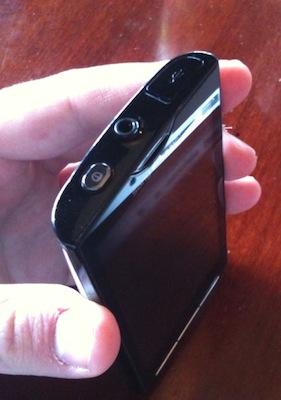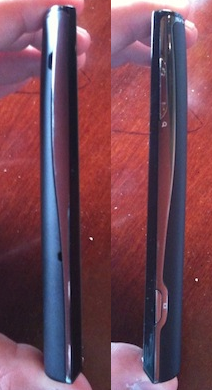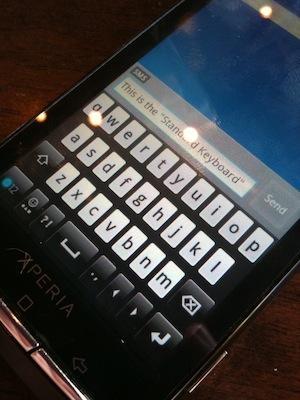
What's Good: Sony Ericsson makes jump into Android territory; vibrant display; rounded curves make for a comfortable experience.
What's Bad: Screen is very inconsistent; on-screen keyboard is terrible; laggy at times.

First Symbian, then Windows Mobile, and now Android. Bucking the trend of many manufacturers in today's market, Sony Ericsson has opted to work with several different operating systems (with the potential for more, according to recent comments made by the company's CEO) as opposed to narrowing it down to a particular focus. As the company's first Android-powered device, will the unlocked (at the time of this review) XPERIA X10 be able to compete with carrier-supported Android devices such as the DROID, myTouch 3G, and the HTC EVO 4G (when it launches)?

The XPERIA X10 is quite clean when it comes to exterior buttons. The top of the unit contains the power button, 3.5mm headphone jack, and microUSB charging port, while the right side of the unit contains the volume rocker and camera shortcut key. The front of the device offers a menu button, home button, and back button. Overall, the design of the X10 is very nice, though I wish the exterior offered less plastic and more metal.

Coming in at 4.69 inches long by 2.48 inches wide by 0.51 inch thick, the device weighs 4.76 ounces, making it thin and easy to fit in a pocket or purse. The X10 offers a 4.0-inch screen with 480 x 854 pixels and 65,536 colors (which I'm told is a limitation of Android 1.6), and I find it to be the perfect balance between the 3.2-3.7-inch market, and the 4.3-inch screens found on the HTC EVO 4G and the HD2. It's big enough, but not overwhelming. Despite the large screen, the X10 is still relatively thin, and feels great in the hand. When conducting a long phone call, I found the unit to be quite comfortable against my ear.

The XPERIA X10 ships with Android 1.6 (Donut), and while I found myself missing Android 2.1, the inclusion of Timescape, Mediascape, and Sony Ericsson's custom UI helped to mask it most of the time. That being said, notable features that I use in 2.1 on a regular basis are missing - the ability to add multiple Gmail accounts, pinch-to-zoom functionality, and voice-to-text, just to name a few. No official word on it just yet, but rumor has it that the unit will be upgradeable to 2.1 at some point (Sony Ericsson has committed to updating the phone on a regular basis).
Despite the 1 GHz Snapdragon processor, the XPERIA X10 was laggy and unresponsive at times. While operating in Timescape and Mediascape (the places where one would think lag would be present), the device performed flawlessly. When attempting to open programs, unlock the screen, or perform basic tasks in the menu, I often found it to be laggy and inconsistent. Additionally, the scrolling itself was erratic - I found that there were times where one scroll did the trick, and other times where it required a few before it recognized the gesture. It's not a deal breaker, but could prove to be annoying after extended use. It's important to note that the software running on our review unit is pre-production software, so things could change by launch time.

The X10 ships with the Android keyboard, and Sony Ericsson's "standard keyboard." After five minutes of using Sony Ericsson's "standard" option, I had to revert back to the Android keyboard due to strange gesture problems. At times, typing would be decent, and other times, it was quirky and would miss letters. For those that frequently message, it's quite the challenge to use. I'm hoping it's either something that can be fixed with future updates, or that there are alternative on-screen keyboards in the marketplace.

The XPERIA X10 ships with an 8.1-megapixel camera with autofocus and flash, and in my testing, picture quality was outstanding. The camera performed well in most situations I was able to throw at it, and video quality was very good as well. Editing options include several "capturing modes" (normal, scene recognition, smile detection, and touch capture), a number of resolutions (8MP, 6MP, 2MP, and low 2MP), a variety of different scenes (normal, portrait, landscape, night scene, night portrait, beach and snow, sports, party, and document), and various focus modes (single autofocus, multi autofocus, macro, face detection, and infinity). Sony Ericsson has always prided itself in high-quality device cameras, and the XPERIA X10 doesn't disappoint.

The unlocked device was tested in the Las Vegas and Charlotte areas using AT&T, and call quality was decent. Callers were able to hear me well, though I had a bit of background static on my end and an occasional dropped call. When visiting a known AT&T trouble spot in the Charlotte metropolitan area, I had trouble initiating calls. When testing the speakerphone in a noisy coffee shop, I was able to hear my callers without a problem. Though they said that they could hear the espresso machines in the background, it didn't prevent us from having a conversation. I successfully paired my Plantronics Voyager Pro Bluetooth headset to the device without a problem, and callers said that I sounded equally clear. The only issue I encountered was the earpiece; it seemed a bit lower than other handsets on the market, even at the highest volume.
The XPERIA X10 offers 3G HSPA connectivity (on AT&T's bands in the US), so browsing speeds were very quick. The full CNN webpage loaded in about 18 seconds, and the PhoneDog homepage loaded in 29 seconds. Other data-intensive tasks such as Google Maps, the Android Market, Google Talk, and Timescape worked well.
Estimated talk time is about 10 hours with 3G connectivity, and about 17 days of standby time. Like other smartphones on the market, the battery life on the X10 isn't going to last that long, particularly during regular day-to-day use. With moderate to heavy use including calling, text messaging, browsing the internet, and use of Google Maps, I was able to get about a day and a half out of it before it powered down. It's no featurephone, but given the abilities of the device, I found the battery life to be acceptable. For the individual that is away from the office on a regular basis, I'd recommend an extra battery or car charger.

The XPERIA X10 has a few quirks and issues that could prove frustrating to experienced smartphone users. That being said, most of the problems I encountered could be fixed with software updates, and since Sony Ericsson has committed to providing updates on an ongoing basis, we could see them resolved over time. At any rate, the X10 is going to be one of those love or hate devices. I hope to see the XPERIA X10 land on a US carrier at some point in the near future, as I think it would make a great addition to any carrier's Android lineup.